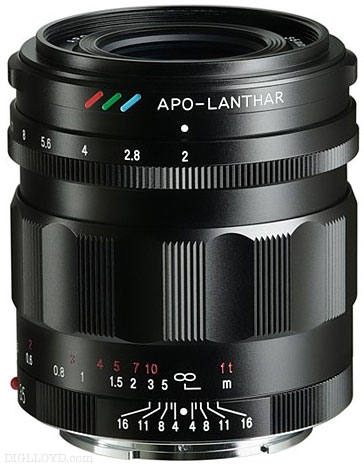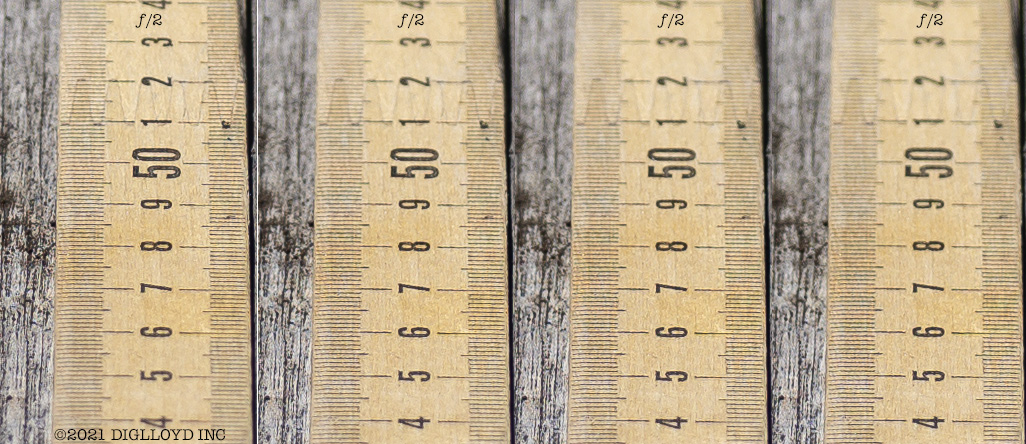Voigtlander FE 35mm f/2 APO-Lanthar Aspherical: what looked like focus shift is *partly* shown to be Focus Creep / Unstable Lens Focus
I just could not understand how a razor sharp lens like the Voigtlander FE 35mm f/2 APO-Lanthar Aspherical could have focus shift—it made no sense in optical terms. So I feel a little 'dense' in not having checked for the lens defocusing itself, just as its 65/2 APO sibling does.
But as it turns out, there appear to be two behaviors going on: focus creep (when not level) that defocuses the lens to a closer distance and some rearward focus shift. Together, the two effects can cancel-out each other.
UPDATE: By shooting two samples with a dead-level camera on a slanted ruler at ~1.2 meters, I have now proven to my satisfaction that (1) there is in fact a rearward optical focus shift, and (2) there was no focus creep involved for this test, as proven by an f/2 frame following the aperture series (it matches the initial f/2 frame).
I have also proven repeatedly that focus creep is an issue, at least at some positions (distances) of the focusing helicoid and when the aperture ring is used and the camera is angled down. The results is increasingly closer focus as the lens jiggles itself to closer focus. There might be variables to the focus creep that I am not aware of yet (e.g., temperature could alter the resistance of the helicoid). Also, sample #2 seems less prone to focus creep.
UPDATE 2: in addition to repeatedly seeing close-range focus shift on a ruler, I now can show exactly the same behavior at a focus distance of ~5 meters, with the camera level, including f/2.8 being sharper than f/5.6 on the leading edge of the subject which starts out slightly OOF.
...

Individual lenses surely vary. But this protocol shows that two (2) brand-new samples of the Voigtlander FE 35mm f/2 APO-Lanthar Aspherical have unstable lens focus *and* focus creep when the conditions are right (mainly when the camera is angled down).
Repeating the following protocol shows the behavior every time with both samples, to a degree so strong that examining the images right in the camera makes it obvious.
I don’t know what factors might also influence it, such as temperature. And while the two samples I have are totally consistent, it is possible that individual lens samples could show it to a greater or lesser degree.
Test protocol for focus creep and focus shift
Be exceedingly careful to touch ONLY the aperture ring when changing aperture.
- Focus at f/2 on a millimeter ruler, or similar, camera pointed down at 30° or so and also with camera level.
- Shoot series at 2, 2.8, 4, 5.6, 8, then again at f/2,
- Shoot 2/8, 2/8, 2/8, 2/8.
- Compare all f/2 frames. They should be identical.
- Check the sharp near and far points on the ruler at each aperture, ascertaining whether focus is increasingly biased rearward (or forward).
By the time this is done, a couple of centimeters of focus difference is seen at f/2 at a distance of ~4 feet—a massive difference.
Example, focus creep
Below are four frames at f/2, from the series {2, 2.8, 4, 5.6, 8, 2, 8, 2, 8, 2}, with the camera angled down about 30°. The focusing ring was never touched; the aperture ring was the only physical contact other than the shutter release. The images are in perfect registration, which rules out the tripod/head moving. There is a whopping 5cm change in focus on the ruler, from 50 to start to 45 by the 4th frame without touch the lens focusing ring. Both lenses show this behavior. On level, I don’t see it change.
However, it seems curiously variable, so I am having trouble pinning things down. Variables might include camera angle, focus distance (because the helicoid will be in a different position), possibly temperature.

Changes to my testing procedures
From now on, my aperture series protocol must change as follows in order to check for stable lens focus, by shooting wide open after the last stopped-down aperture:
f/: 2, 2.8, 4, 5.6, 8, 11 ===> 2, 2.8, 4, 5.6, 8, 11, 2
It’s going to be difficult if not impossible to test lenses with unstable lens focus. Comparisons will be fraught with the hazard of never being certain as to whether focus has moved. I’ve tried tape—no good; it allows a bit of shift and total PITA in the field. A rubber band for more friction might work, but finding the right width and diameter is a chore.























